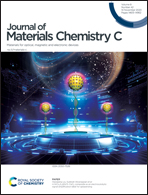Degradation of fluorescent organic light emitting diodes caused by quenching of singlet and triplet excitons†
Abstract
We investigated the degradation mechanisms of fluorescent organic light emitting diodes at an early stage of the device degradation via time-resolved photoluminescence (TRPL) and time resolved electroluminescence (TREL). The TRPL of degraded devices demonstrates a decrease in photoluminescence (PL) lifetime of the singlet exciton of an emitter, suggesting that the degradation is partially due to the decrease in the PL quantum yield owing to the quenching of the singlet exciton. Capacitance–voltage measurements of the degraded devices indicate the formation of trapped positive charges. The quenchers of singlet excitons could act as trapping sites for positive charges. No change in PL lifetime under electroluminescence (EL) suggests that the device degradation may not be caused by the quenching of the singlet exciton owing to the trapped positive charges. The TREL of the devices shows delayed EL in the microsecond time range originated from triplet–triplet annihilation (TTA). The TREL of the degraded device demonstrates a decrease in the delayed EL intensity, which suggests a reduction in the yield of singlet excitons through the TTA process. The decrease in the yield of singlet excitons is attributed to the quenching of the triplet exciton by trapped positive charges.



 Please wait while we load your content...
Please wait while we load your content...